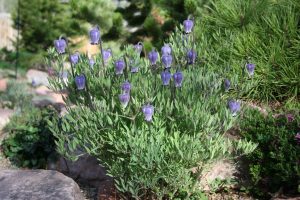Scott’s Sugarbowls: A Mounding Clematis for Gardeners and Pollinators!
Scott’s sugarbowls (Clematis scottii) is a versatile, long-lived herbaceous plant native to the front range and steppe regions of the Rocky Mountains in northern New Mexico and southern Colorado, but it can be grown in a much larger range of conditions throughout Zones 4-8.
Scott’s sugarbowls provide contrast in the garden with their unique blooms and seedheads. They grow to 12” tall by 15” wide, though will take a little time to reach this size. The one-inch flower bells hang from naked stems above lush green foliage. The blooms are dark blue toward the stem, gradually shading to white at the upturned edges of the petals. As the season progresses, these open to reveal unique blond seed heads of silky tousled strands, almost showier than the flowers. Scott’s sugarbowls are a cultivar of Clematis hirsutissima. Scott’s cultivar is not only smaller, but it continues blooming over a much longer season.
If your garden receives regular water, it acts like other clematis, preferring to have its base and roots in the shade and its head in the sun all day. If the soil is dry though, it likes some afternoon shade. The soil needs to be well-drained, but the composition may be loam, sandy or amended clay. These clematis are generally pest and disease free, but avoid overcrowding and overwatering in order to keep them free of mildew and slugs. It is deer and rabbit resistant.
Sugarbowls may be planted in spring or fall. They can also be raised from seed. To succeed, plant the seeds in a pot in the warmth of autumn. Then give them the cold of winter by placing the pot of seeds outside on the north side of your home. Water occasionally or cover with snow. The seeds will germinate in the spring as you bring them out into the sun. Alternatively, you can plant the seeds out into the garden in the fall, marking their location with a tag, and they will come up according to their own clock.
The plants may be used in perennial beds, rock gardens, xeric or native landscapes. For a blue/violet color scheme, try planting sugarbowls with Crystal RiverⓇ veronica (Veronica ‘Reavis’) or Little TrudyⓇ catmint (Nepeta ‘Psfike’PP18904). For a contrast in foliage color, plant with partridge feather (Tanacetum densum subsp. amani) or artemisias. To create the feeling of depth, use a contrast of scale, both in front and behind your sugarbowls. In front, use shorter plants like goldhill golden aster (Heterotheca jonesii x villosa ‘Goldhill’), filigree daisies (Anthemis marschalliana) or SnowmassⓇ blue-eyed veronica (Veronica x ‘P018S’). Behind, plant taller perennials like Prairie JewelⓇ penstemon (Penstemon grandiflorus ‘P010S’) or Grand Mesa penstemon (Penstemon mensarum) that bloom at the same time as sugarbowls. To complement the sugarbowl seed heads, try grasses behind it, like Mexican feather grass (Nassella), or things that bloom later like silver sage (Salvia argentea), or Bridges penstemon (Penstemon rostriflorus).
Visit your local nursery to gather more ideas and above all have fun and let your imagination play.
Height: 12”
Width: 15”
Bloom: May-July
Sun: Full sun
Soil Moisture: Moderate to Xeric
Hardiness: USDA Zone 4-7
Thanks to Carol Shinn for this article!



Leave a Reply